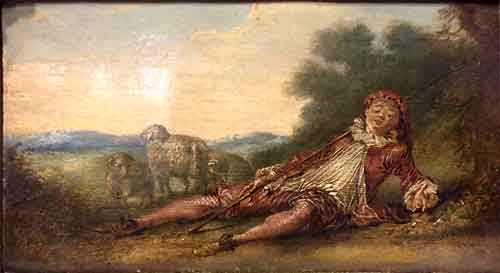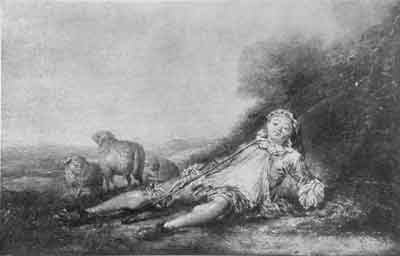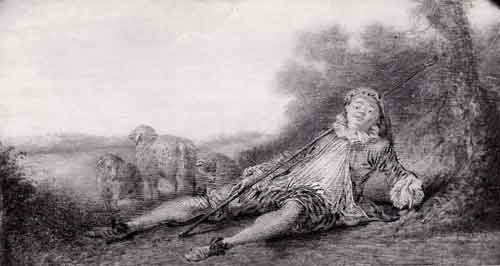
- Home Page
- Accepted
Paintings & Copies - Doubtful
Attributions - Doubtful Textual References
- Alternative
Titles - Collectors &
Museums - Bibliography
- Search Abecedario
- Watteau &
His Circle
X. Le Berger rose
Entered February 2015; revised May 2025
Whereabouts unknown
Oil on oak panel
12 x 23.2 cm
ALTERNATIVE TITLES
Le Berger
Berger rose
PROVENANCE
Paris, collection of Jean-Louis Dulong (1800-1868; painter). His sale, Paris, Hôtel Drouot, April 1, 1869, lot 63 “WATTEAU . . . “Le pendant.”
Paris, collection of Monsieur Gélis; His sale, Paris, Hôtel Drouot, March 22, 1875, lot 51: “WATTEAU (JEAN-ANTOINE) . . . Mascarille berger. Vêtu d’un pourpoint rayé, et à demi couché sur l’herbe; il tient en main une houlette; au second plan, paissent des moutons. Pendant de precedent. Bois. Haut., 15 cent,; larg., 23 cent.”
Paris, collection of Jules Burat (1807-1885, journalist and professor at the Conservatoire des arts et métiers). His sale, April 28,1885, lot 206: “WATTEAU (ANTOINE) . . . Mezzetin berger. Couché au pied d’un arbre, vue de face, habit violacé; une houlette à la main. il garde des moutons. Bois. Haut., 12 cent., larg., 23 cent.” This picture and its pendant sold together for 5,000 francs according to Adhémar.
London, Wildenstein, c. 1951.
Private collection.
Paris, sale, Hôtel Drouot (Boisgirard-Antonini), May 30, 2018, lot 103: "Huile sur panneau "Le berger" (porte un cartouche Watteau). [est.] 100 - 120 €."
EXHIBITIONS
Paris, Galerie Martinet, Collections d’amateurs (1860), cat. 432 (as by Antoine Watteau, Mezzetin berger, lent by M. Burat).
London, Wildenstein, Watteau & His Contemporaries (1930), cat. 30 (as Watteau, The Pink Shepherd).
London, Wildenstein, The French XVIII Century Interior (1951), (as by Watteau, Berger rose, from Wildenstein).
SELECT BIBLIOGRAPHY
Horin-Déon, “Cabinets d’amateurs“ (1861), 247.
Adhémar, Watteau (1950), cat. 309.
Mathey, Watteau, peintures réapparues (1959), 25, 66, no. 8.
Macchia and Montagni, L’opera completa di Watteau (1968), cat. 2o-X.
Eideberg, “The Young Lancret and Watteau” (2015).
REMARKS
Until now the earliest known provenance for this painting and its pendant had been the Burat sale in 1885. The recent discovery of the paintings in the Gélis sale of 1875 allows us to push their provenance in Paris ten years earlier. Moreover, we posit that they were in Paris still six years earlier at the Dulong sale in 1869, where they were sold with minimal description and no measurements. There are few alternate possibilities in the oeuvre of Watteau and his school that are pendants, each of which features just one resting shepherd. Our association of the Berger rose with lot 63 rather than lot 62 (described as “Berger au Repos”) is for convenience but is admittedly arbitrary.
There has been considerable confusion about the identity of the commedia dell’arte character in this painting. At the Gélis sale he was described as Mascarille (a sly servant in Molière's comedies) and as Mezzetin at the Burat sale. He is indeed a Mezzetin, an actor easily recognizable by his pink or red-striped suit. However, in recent times the actor in the pedant, wearing a black costume, has wrongly been identified as “Mezzetin berger.”
When in the Burat collection, this painting and its pendant, both thought to be by Watteau, were described by Déon as “gracieuses, fantaisies pleines d’expression et de poésie.” Whereas contemporary scholars such as Réau and Adhémar rejected the old attribution to Watteau, Wildenstein and Mathey unconvincingly tried to retain the idea that the picture was indeed by him. The more recent classification in 1988 and 1989 of the pendant to the “entourage de Watteau” is more reasonable.
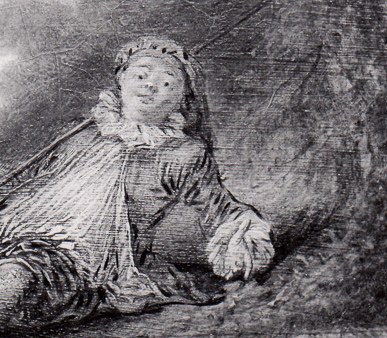
Nicolas Lancret, Berger rose (detail).
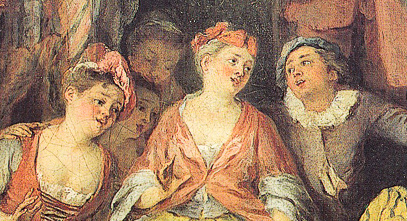
Nicolas Lancret, Concert dans un parc (detail), oil on canvas. Whereabouts unknown.
Moreover, the attribution of the painting can be refined further. The facial features of this comedian—his slightly parted lips, large eyes, flared nostrils, and large, rounded eyes—suggest, instead, that this painting was executed by the young Lancret in the late 1710s. Comparison with some of his earliest works, such as his Concert dans un parc, show that these featurs are analogous.
X. Le Berger rose (copy 1)
Entered February 2015
Baden (Switzerland), Museum Langmatt, inv. 71/GZ
Oil on canvas
15 x 23 cm
ALTERNATIVE TITLES
Berger
Scapin als Hirte
Scapin berger
PROVENANCE
Paris, collection of Camille Groult (1837-1908). This provenance was claimed by Wildenstein.
Paris, Galerie Wildenstein, by 1920 when the picture was sold to Sidney William Brown (1865-1941, engineering industrialist) and his wife Jenny Sulzer (1871-1968).
Baden, Brown-Bovery collection. By descent to their sons, and donated in 1987 as part of the Stiftung Langmatt Sidney und Jenny Bower
SELECT BIBLIOGRAPHY
Courthion, “La Collection Brown-Bovery” (1926), 27-29.
Mathey, Watteau, peintures réapparues (1959), under no. 8.
Macchia and Montagni, L’opera completa di Watteau (1968), under cat. 2o-S.
Preiswerk-Lösel, Ein Haus für die Impressionisten, cat. 148.
Eideberg, “The Young Lancret and Watteau” (2015).
REMARKS
While the early provenance of the Baden museum’s painting is largely undocumented, it seems likely that it and its pendant were attributed to Watteau himself. Certainly this was the way they presented in the 1920s and still in the 1950s. Curiously, during all that time there was no mention that they were copies of the pictures that had been in the Burat collection. Rather, Wildenstein presented them as though they were the very paintings that had been in the Burat collection and then in the Groult collection.
Mathey appears to have been the first to publicly recognize that they were but copies. He retained the old attribution of the ex-Burat paintings to Watteau, but it would seem that he made no such claim for these copies. Presently the museum classifies them as French works from the first half of the eighteenth century.
The Baden pendants are not exact replicas of their models. In the case of the Berger rose, the tree trunk at the far right side has been eliminated and the foliage there has been generalized. Also, because of the changed proportions, the area devoted to sky has been increased. These changes can be read as simplifications of the original composition.
The important question remaining, then, is the identity of the artist who executed the copies. Although I believe that the ex-Burat picture was painted by the young Lancret, it is not certain that he also painted this version. Judging from photographs, there seems to be a slight but significant difference in the rendering of the faces and the drapery—enough to suggest that the Baden paintings may be by a different hand.
